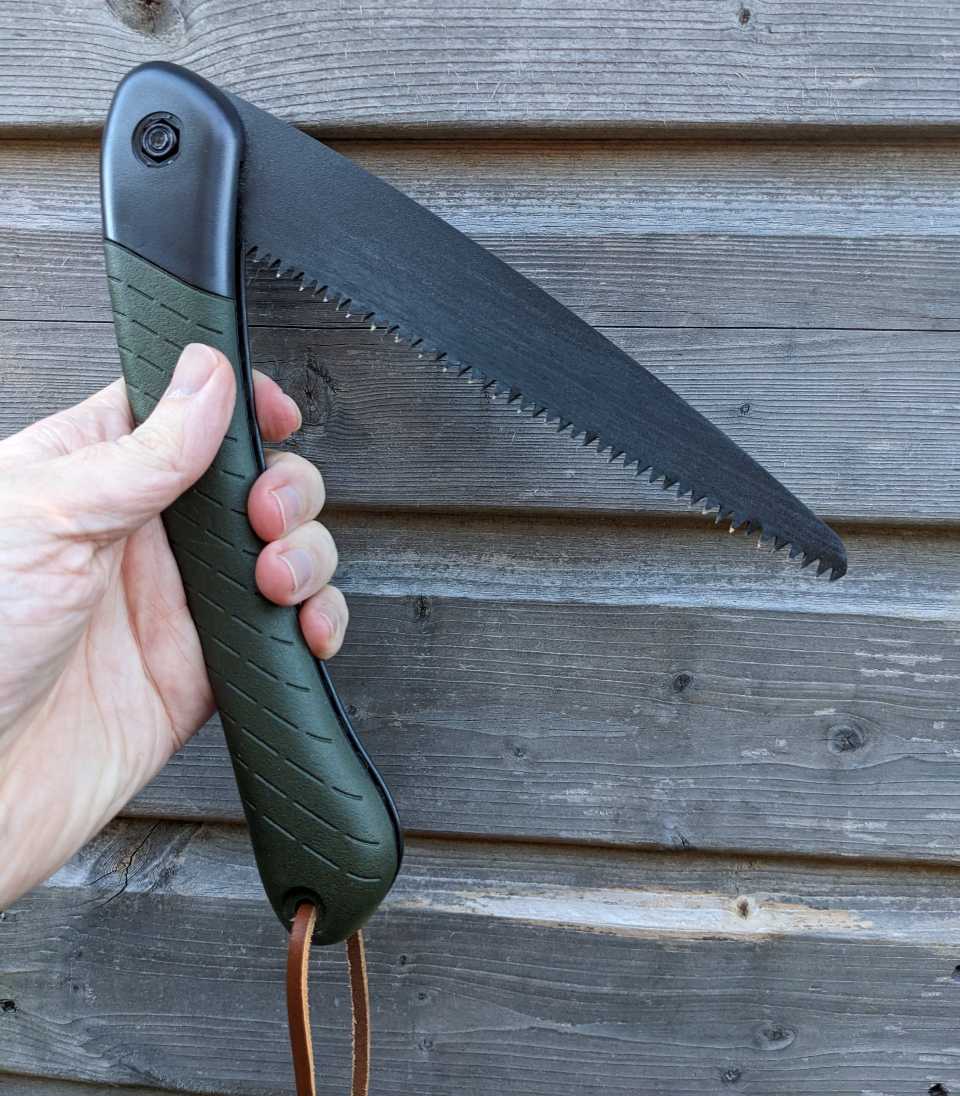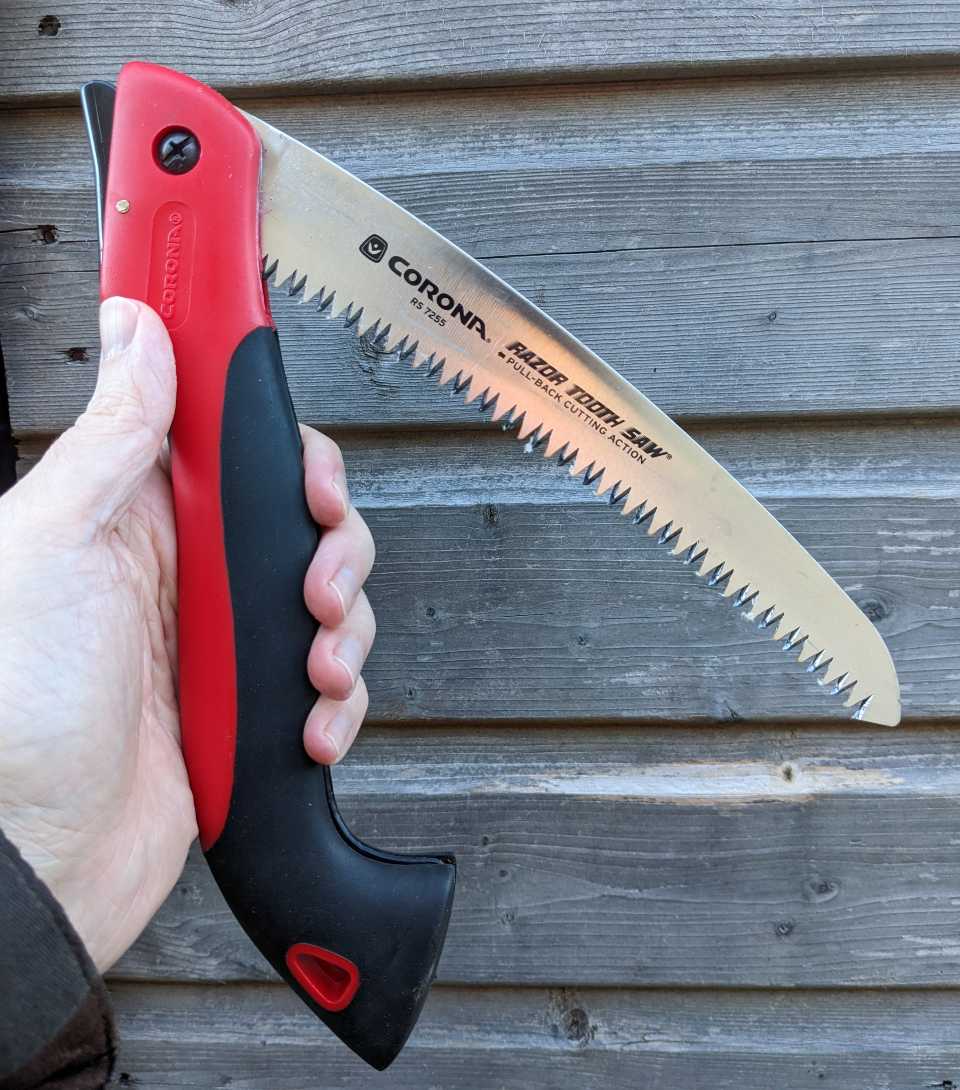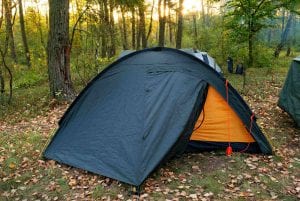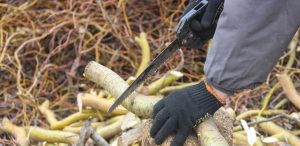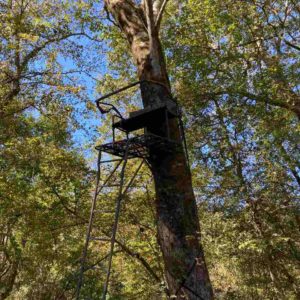While some ultra-lighters might question the benefits of even the best backpacking saw, there’s no doubt that it’s a tool plenty of backpackers want in their kit – extra ounces be damned!
If you want a campfire, a good saw is extremely useful. If you want to do any sort of trail clearing, a saw is pretty much indispensable. And anyone who does any bushcraft activities would be lost without one.
When looking for the best backpacking saw, it really comes down to 4 main features:
- Saw Design (you really want a folding saw, a bow saw might be OK at a push, forget pocket chainsaws)
- Big Teeth (big teeth saw faster and more efficiently than small teeth)
- Long Blade (the longer the better for efficient cutting but obviously the shorter the better when it comes to utilising limited space)
- Lightweight (the lighter the better, unless you have to compromise on cutting ability and durability)
And so, with all that in mind, it really comes down to the same recommendation as you will probably see everywhere else… the Bahco Laplander.
It’s by no means perfect! But there’s a reason it’s the go-to folding saw for so many backpackers (and bloggers): it does the job.
It’s definitely not the only option out there, though. Others you might do well to consider include:
- Silky F-180 or the Silky Pocketboy (really lovely saws, super sharp, very popular)
- Opinel No.18 (looks amazing and cuts well but ultimately we found it disappointing)
- Corona RazorTooth (dirt cheap, razor sharp and completely unpretentious; a surprise hit!)
Bahco Laplander – Best Backpacking Saw
The Verdict
The Bahco Laplander is a mainstay of the outdoor community when it comes to folding saws. It’s really light, really compact and is an absolute workhorse.
In the same way that “nobody ever got fired for buying IBM”, if you buy a Bahco Laplander you’re simply not going to be unhappy.
There’s a few things in particular that make it really stand out from the crowd. It is a really lovely design. It’s the smallest saw on this list which is one of the reasons it’s such a great camping saw; super easy to slip into a pack or onto a belt. And it feels great in-hand; a solid piece of kit that’s very nicely balanced. Finally, the fact it locks closed as well as locking open is a huge plus; it’s not going to fall open in your pack and accidentally chew up your expensive down sleeping bag, for example!
But it’s by no means perfect.
In this reviewer’s opinion, there are better blades listed in this article. The Laplander blade is shorter than other backpacking saws discussed here. And the teeth are smaller. Each of those things means that when it comes to raw cutting power, the Laplander is not the best backpacking saw out there. In fact, both the Silkys, the Opinel and the Corona all cut better straight out the box; requiring fewer strokes and less pressure.
But while that should be enough to downgrade the Laplander. It isn’t. That’s partly because you get the sense it’s a bombproof saw – it’s not in the least bit flimsy (the same can’t be said of all the other saws on the list). And that, along with the other positives mentioned earlier, means that the Laplander is the smallest, lightest and possibly the most durable folding saw on the market.
Which is ultimately why it tops this list.
Availability
You should be able to pick up a Bahco Laplander from the following stores:
- Check out the prices on Amazon >>
- Check out the prices at Walmart >>
In Summary
This is almost certainly the best backpacking saw for most backpackers, most of the time. It’s really small and really light. It’s extremely durable. And it cuts really well.
If you want a camping saw that performs cutting tasks better, you may well prefer a Silky Pocketboy or Silky F180, because they undoubtedly come with better blades (along with their own downsides).
If you’re tight on budget and don’t mind about size, then the Corona RazorTooth might be better for you.
Corona RazorTooth – Best Budget Backpacking Saw
The Verdict
As one of the cheapest folding saws on the market, the Corona RazorTooth isn’t actually marketing as a camping saw at all! But it is ideal for backpackers on a budget.
It’s suitable for a number of activities when backpacking or camping, such as cutting a range of different types of wood, branches, and rope. The saw is small enough to fold away and carry in your bag or clip on to your belt.
The sharp blade is long enough to cut a range of materials relatively, quickly but also small enough to be handheld and fold away for safety. The aggressive teeth make cutting softwoods effortless, but with hardwoods, you need to establish a good groove to get a rhythm going.
The Corona saw is highly durable and comfortable in the hand. It unfolds relatively easily — but not too easy that children could do it by accident — making it a safe choice.
The blade length is great for cutting through medium-sized tree branches; however, it’s not a handheld chainsaw that would be used to cut down trees. When used for the correct purpose, this foldable saw is a real winner.
The price tag is on the lower side too, so it’s good value for money and will last you many a trip.
In Summary
The Corona Razortooth is the best folding saw for backpackers on a budget. You have to work harder using these sort of saws than you do with bow saws. But it’s light, durable, safe, and comfortable, as well as affordable. What else could we want?
At less than 8 ounces, it’s not going to weigh you down when you’re out and about in the wilderness, so it’s ideal for hikers and backpackers.
Gerber Freescape Camp Saw Review – Best Backpacking Saw


Specs
The design of the Gerber Freescape Camp Saw means it to fold up flat without breaking it into separate components, so there’s no worry of lost parts. The handle is made from a textured rubber, to ensure a superb grip no matter the conditions. The blade length is 12 inches.
The Verdict
As backpacking saws go, this has to be the best for a bunch of reasons. Its more traditional four-point design means you hold it more like a normal saw than cheaper pocket-knife-style hand saws. This makes it more comfortable if you will be sawing for long periods of time — which may be required when out and about. The position of the handle makes grip and wrist position easier too, so you’ll experience less wrist strain.
When folded up, the blade is safe and covered, so it can be stowed safely in your backpack. The bright green accents make it more visible when you’re digging through your stuff looking for it or if you left it lying around.
As it’s a bow saw, it may not be suitable for jobs in smaller areas as it could get in the way of the fluid movements if there are lots of branches or items around what you’re cutting. The fact you can use standard blades means it will be suitable to cut through a range of different materials you might find on your travels — not just the firewood.
The 12 inch blade length is a common size meaning that you can very easily pick up some spares and have a small stash of razor sharp blades if you need any replacements.
In Summary
The Gerber Freescape Camp is an awesome backpacking saw. As a folding bow, it’s easy to cut for long periods of time AND it’s super-easy to store and travel with. Unlike some folding saws, it folds down without you having to take off any parts, making it easier to set up the next time and less likely to lose any sections.
This is a more pricey saw, though, at the higher end of our selection, but may be worth it if this is more your style of saw. If you’re anything like me, you’ll always end up leaving something behind when you backpack, so make sure it’s not this!
Pocket Chain Saw with Paracord – Do Not Buy

Specs
This saw can be used to cut trees and branches at ground level. The product is available in three different sizes: 24 inches, 36 inches, and 48 inches.
The design includes heavy-duty strap handles and teeth made from carbon steel. Included is a nylon pouch with a sturdy snap and belt clip for easily carrying it around and to make sure it’s within reach when you need it.
The Verdict
This only manual chainsaw is totally different from folding saws (and it’s the only one I have on this list), and is super-handy in specific situations. Depending on the size of chain you select, cutting small to large branches and stumps will be easier and the work is spread between two hands rather than just one.
The strong carbon steel blade is great for cutting through a range of wood types, including some hardwoods. The problem is many other tasks you find when backpacking may not be suitable for this type of saw and you may want to have a camping axe for splitting purposes.
The large grips are ideal for getting a good hold of the handles in order to create some power in the cutting motion, while still being comfortable. The fact they are oversized means they are suitable to use even when wearing thick winter gloves, which is ideal when spending time outside in the wilderness.
In Summary
As pocket chainsaws go, this is one of the best. This saw could make sawing down some bigger stumps or trees slightly easier than a one handed saw, but you’d need a different saw for most other tasks.
This product is portable and lightweight and will make a great addition to your backpacking gear. Although it’s at the more expensive end of our list, it’s still not too pricey for a specialized item like this and should last with its protective pouch.
Hooyman Extending Saw Review


Specs
This saw extends to 5 feet when open and collapses to 12 inches when folded for portability. There are also 10 foot (collapses to 28 inches) and 16 foot (collapses to 48 inches) models available.
The handle features an I-beam aluminum construction, and the lock back blade is made from high carbon SK5 steel combined with a hardened four-edge MegaBite XP design which boasts a longer cutting life.
The Verdict
This extendable saw by Hooyman is ideal for cutting branches or other items that are higher up or further away when required. The strong four-edge tooth design makes cutting through tough wood and other substances easier.
As the pole is collapsible, it’s perfect for a number of different tasks you may face when out in the wilderness or on a hiking trip with the family. It can also be used as a hand saw for smaller, more intricate jobs.
The in-line design allows the folding tool to slide and lock into the extension arm. This locking extension system ensures you can saw safely, and along with the ability to collapse the pole, makes it easier to use and carry around. It also comes apart when only a handsaw is needed.
The saw once fully extended can be strong but may not be able to take on the tougher jobs when extended right out.
In Summary
For tasks that need a longer reach, this extendable saw is perfect as it can extend up to 5 feet (or more, depending on your selection) or it can be separated and used as a hand saw. Its locking system makes it a safe option if you need something this specific.
Unless you definitely need a longer reaching saw, you could get the same quality tool to make sawing easier, faster, and more comfortable for less money.
This saw is at the higher end of the price bracket, but in terms of extendable saws, this is your best option as the qualities of this product are very promising.
Alternatives
This is obviously quite a different beast to, say, the Gerber Freescape Camp Saw. And if you’re really needing the extra 5 feet of reach, then it’s obviously the right option to go for. But if you don’t need the extension, you will probably prefer the Gerber.
Könnig Heavy Duty Pruning Saw


Specs
This heavy-duty saw features a curved blade made from high-grade steel. It has a 14 inch blade and features large teeth to make cutting easier and faster. In total, the saw measures just under 20 inches, meaning you’ll have to make room for it in your backpack.
This saw comes with a durable black polypropylene sheath to cover the blade and a detachable belt holder so you can keep it in easy reach when needed.
The Verdict
This professional Könnig saw is perfect for cutting through branches and bushes with ease due to the razor-sharp carbon steel blade. With a strong and versatile design, it’s best for heavy-duty cutting, so if you’re going to be chopping a lot of wood along the way, this might be for you.
Grab on to the curved handle and you’ll feel a comfortable grip along with a toughness that makes it almost easy to cut through a range of woods. The non-slip handle absorbs vibration, a feeling which becomes tiring after a while.
The Japanese tooth design on the blade boasts the optimal combination of flexibility and strength to make cutting a smooth and enjoyable task.
This is a very specific type of saw which may not be relevant for some tasks when out backpacking, unless you’re going somewhere where the branches are high up. If you’re looking for performance over portability, this saw is very efficient.
This product is not going to cut down great big trees, but for branches, it works very well. It’s larger than most other backpacking saws, but it’s still easy to store and carry when out camping or hiking.
In Summary
This saw would be ideal for someone who knows they’re going to need to cut branches higher up or do lots of wood cutting. The heavy-duty saw has strong teeth on its curved blade, making it suitable for cutting a number of different types of wood and some other materials. The curve allows a groove to be made and stuck into it easier and quicker.
The professional grade saw comes at an affordable price. This saw is overall a versatile saw but as it only has a soft casing, it’s not the safest when packed away.
How to Choose the Best Backpacking Saw
Fortunately, backpacking saws aren’t the most complicated of tools. While there are quite a lot of choices out there, you’re not looking at having to make a lot of complicated trade offs. Here’s a run down of the main discussion points:
- Backpacking Saw Design: Should you go for a bow saw, a folding saw or a pocket chainsaw?
- Size & Weight: How light and compact can you get away with?
- Teeth Per Inch: Understanding how TPI impacts cutting efficiency…
- Safety
Backpacking Saw Design
There’s no need to over-complicate this. A bow saw has the most efficient cutting action but is the heaviest and bulkiest option. A pocket chainsaw is the lightest option but has a quite a limited cutting ability. A folding saw can either be a happy compromise or the worst of both worlds, depending on your perspective!
Folding Saw
A folding saw design is like a folding knife but with razor sharp teeth. Folding camp saws typically have a blade length ranging from 8″ to 14″. You can go longer (as well as shorter) but when it comes to a folding saw for backpacking, you probably want to stick to this range.
With a folding saw you can generally choose between a straight or curved edge. Straight edge saws tend to be better for thicker logs. A curved edge can be a bit more ergonomic but limited to pruning trees of their smaller (dead) limbs.
A folding saw with a straight edge and a long blade (even if it’s a high quality steel blade) can require quite a bit of effort on the pull stroke. A curved saw with a short blade length can also make pull strokes challenging when cutting wood on all but the thinnest of branches.
Saw blades tend to be more difficult to replace with a folding saw compared to a bow saw. But assuming it holds up well, the advantages are that a folding saw will generally be lighter, more compact, simpler to assemble and you won’t be limited to the size of logs you can cut.
At the end of the day the best folding saw is going to be lighter and more compact than a bow saw, so for those reasons alone they are the go-to choice for a backpacking saw.
Bow Saw
A bow saw looks like a hacksaw. It typically has a four-point design and the positioning of the handle means those pull strokes require a lot less exertion than a standard saw blade, making for efficient cutting.
Replacement blades are readily available and easy to fit, meaning you are less likely to be left high and dry if your saw’s blade breaks.
Some portable bow saws require a bit of a assembly, which is undesirable. But if you can find a folding model (like the Gerber Freescape), then you’re onto a winning backpacking saw.
The biggest downside to this design is that you are somewhat limited to the size of logs you can cut. Thick logs will be difficult. Although arguably you shouldn’t be cutting thicker wood anyways.
Pocket Chainsaws
Finally, if you want to ditch saw blades altogether, then you might think a pocket chainsaw would work for you. Not a backpacking saw as we know it. But they are incredibly lightweight so… maybe they are worth it?
Just a chain and two handles…?
DON’T BOTHER!
Seriously, just don’t even waste a thought. They just. Don’t. Work.
Size and Strength
As we’re talking about saws for backpacking, it’s key to look at the size of the saw. You need something which is small enough to pack in your backpack along with your other things, place in your back pocket, or clip on your belt for easy reach.
Some of the best saws for backpacking are those which fold away, similar to the Swiss Army knife, so many tools all just pop out and back in again. Is this the kind of camping saw you think you need? Or are you in need of one more heavy-duty for bigger tree stump cuts?
The size of the whole tool is important for storage and travel purposes, but the size of the blade is vital too. The length of the blade will affect what you can cut or work on — small blades less than around 7 inches won’t cut any branches bigger than a few inches across and probably only softer woods.
The size and strength of the teeth are important, as this will be the cutting tool itself. Most teeth have serrated edges to give a sharp cut.
Material
The material of the blade is a critical element, so it needs to be strong, durable, and slightly flexible. If it’s too rigid it could snap easily and won’t work in many situations.
The most common material is steel or high carbon steel. This is because it’s relatively cheap to make but also particularly strong and durable, making it ideal for sawing trees and branches as well as other materials you may face along the way.
Another section of material that is relevant is that on the handle. This needs to be comfortable, have a good grip, and be strong for persistent use. Similarly, if you’re looking at a folding saw, make sure the hinges and joints are top quality, as these could be a potentially weak link.
The most common grips are made from plastic, as they are usually strung and relatively lightweight, which means less extra added weight to your backpack. Saws often have a rubber grip over the top of the plastic; this is to make it more comfortable to use as well as offer a better grip. When backpacking, you’re often exposed to the elements, and having a rubber overlay or grip on the handle can make it easier to hold and less likely to slip or drop if it rains.
Weight
Similar to size, the weight of your backpacking saw is critical. Of course, you’ll want something that’s lightweight and portable, because you’ll have to carry it. Look for something that is light so you can take it everywhere you go. You may also want a tool that is compact, in which case look for a folding saw as an excellent option (and a good folding bow being the very best).
Purpose
When traveling or exploring nature, you may need a saw for a range of purposes. If you’re a seasoned backpacker who visits their regular spots, you’ll know exactly what style of saw you’ll need for most of your tasks and may be able to choose something more specialized.
If you’re looking to cut small to medium branches or trees, then bow saws between 7 and 12 inches long will probably suffice. If you’re looking to cut down larger trees or branches, then a manual chain type saw might be better and more suited to your needs.
And don’t forget to consider teeth per inch. A high count of teeth per inch will give a finer cut but will take longer to saw. We’re probably in the market for fewer teeth per inch because, while it will give a rougher cut, it will saw quicker and we don’t really care about the finish when we’re burning the wood!
Safety
If you’re traveling with children or even pets, you’ll need to make sure they are safe. When finding your perfect backpacking saw, make sure it fits the needs of your party.
This means potentially dangerous equipment such as saws need to be securely stowed away, covered, or locked so small hands and paws can’t get to them and injure themselves. Folding saws are very effective at this.
Most of the saws listed above do lock away or come with a cover, as we take safety very seriously. However, you must always ensure you have them in the safety position when you put them away — you can never be too careful.
Conclusion
To round up, the best backpacking saw depends on your requirements and needs. You’ll need something which is lightweight, easy to transport, and hard-wearing.
The winner of the roundup has to be the Gerber Freescape Camp Saw. It ticks all the boxes and more. It folds up into a compact shape, is lightweight, comfortable to use, cuts through materials efficiently, and is safe.
The Chainmate Survival Pocket Chain Saw come in as a runner up. It offers something unique, durable, and practical, but is more specialized in its use.
When searching for the best backpacking saw, you need to think about what you want to use it for. It also depends on your budget and what is the best value for money for you.
And if you liked this article, you may also enjoy our roundup of the best backpacking axes here >>

